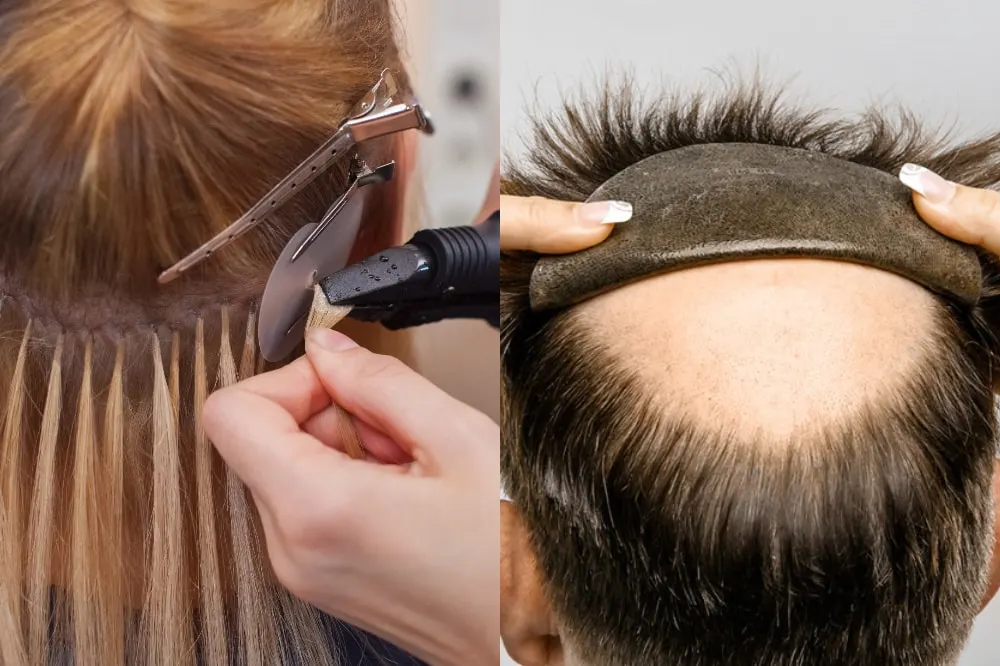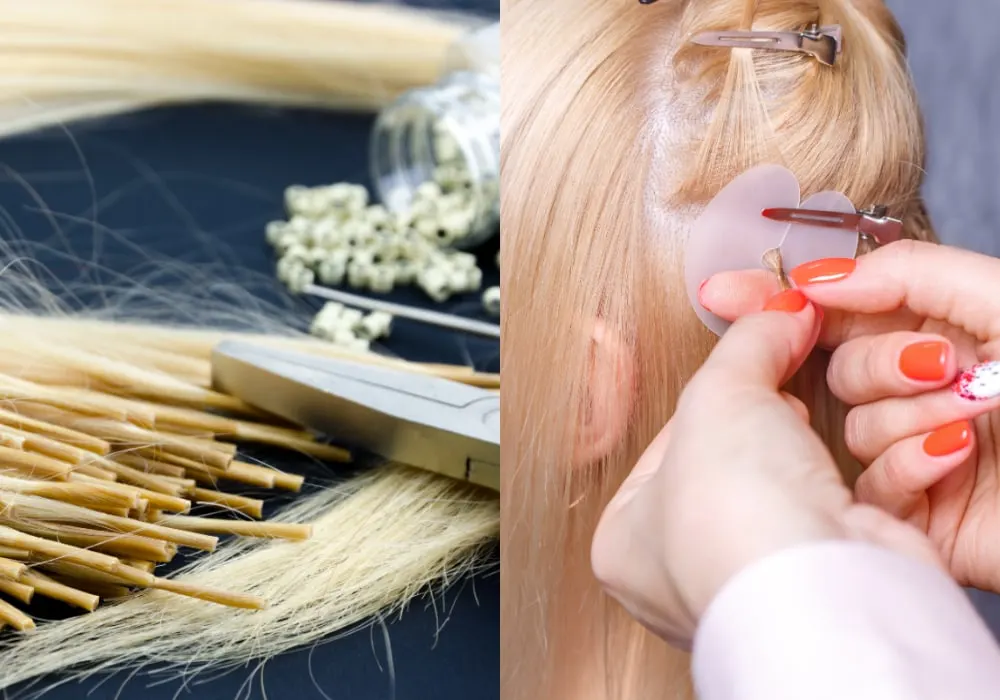Hair bonding is a fantastic treatment for those of us seeking some versatility in our hairstyles. Be it for culture or how you view your self-image, your hair is an integral part of you. However, for those of us who choose to grow out our hair and style it, there are occasional obstacles.
Sometimes your hair isn’t long enough for what you want or doesn’t have the right volume. For others, hair loss or thinning can be frustrating and cause doubts in self-confidence.
Whether for styling and cosmetic purposes or to fill in some thinning hair, bonding is a process that allows you to add extensions to add volume or to fill in bald spots.
Here’s everything you need to know about and what you can expect from the process.
What Is Hair Bonding?

Not to be confused with hair treatments that focus on repairing your hair’s natural bonds, this hair bonding refers to a hair replacement process. With bonding, bond glue or tape is used to adhere hair wefts and incorporate them into your hair.
There are different types of bonding hair methods, and they can be done either professionally or on your own. For some, the process only consists of gluing wefts to your own hair. However, you can also use hair bonding systems.
A system refers to larger pieces for hair replacement, such as wigs or weaves. They’re painless and often cheaper alternatives to surgical hair replacement. A bonding system must be maintained but can last for months.
Pros and Cons of Bonding Hair
So is hair bonding suitable for you? Let’s go over some pros and cons:
Pros
- Can be done at home with some help
- Allows for a variety of styles and colors
- Painless hair replacement process
- Cheaper than hair replacement surgery
Cons
- Requires regular maintenance
- Systems will have to be replaced about every six months
- Time and money for recurring salon visits
- Not viable for anyone with a skin allergy to the adhesive used
Who Should Try Hair Bonding?
Anyone can try hair bonding as it has a couple of appealing uses. For example, the extensions can give you extra volume and length for styling purposes, or you could fill in parts of your hair that may be experiencing thinning to restore a fuller look.
However, this isn’t for you if you’re allergic to the adhesives used for the process. Double-check what kind of bonding glue or tape you’re using, and do an isolated skin test before bonding hair.
How to Get Hair Bonding
An extra set of hands will be needed for the process, whether at home or in a salon. Therefore, it’s highly advised you ask for help in the process.
At Home DIY Hair Bonding

You’ll need hair bonding glue or tape, the wefts you want to use, and a glue solvent for when it’s time to remove the extensions. You can buy all of these at various hair and beauty stores.
For preparation, ensure your wefts are the length and width you want and cut them accordingly. You’ll also need to wash your hair, so it’s clean, but don’t use conditioner. The product can make your hair oily, and the adhesive will have a more challenging time bonding.
Once your hair is dry, part and clip your hair out of the way so you can easily access where you’ll be applying the wefts.
Dab small dots of the hair glue to the strip at the top of the weft – do not use the glue directly to your hair – then place the weft to the section of hair you want it adhered to.
You want to get as close as possible without applying it directly to the scalp. Never use bonding glue or tape directly on your scalp. Press along the weft hairline for about 30 seconds.
Then take a blow dryer on low heat and gently blow dry the area. The heat will help the glue dry quicker and form a good bond for the weft.
Repeat the process by adding another layer. When the extensions are to your satisfaction, carefully brush your hair and style it as you please.
Salon Hair Bonding

If you’ve never had a hair bonding, especially a system, before, it’s a good idea to seek professional help first. Many salons offer the service of bonding hair and helping you maintain it.
The stylists can also answer any additional questions you might have about care. There are several methods, and each salon is different.
Depending on the system’s size and complexity, you must get one custom-made to fit. They’ll help you with that since your head and scalp will need to be measured and potentially have a mold made.
Once the system is ready, your stylist will set and install it. Factors vary, of course, but every 3-4 weeks, you’ll need to go back so they can remove, clean, and replace the bonding system.
FAQs
Here are some frequently asked questions about hair bonding. Look them over for tips on how to care for and maintain your extensions.
Bonding hair isn’t exactly a permanent solution. Because it has to be removed eventually and then reapplied if you wish, it’s a temporary solution. It’s up to you if you want to keep up.
How long it lasts will depend on the kind of hair bonding. Simple DIY hair bonding weft can last about 4-6 weeks, depending on wear and maintenance.
Larger hair bonding systems can last up to 6 months but need regular maintenance every four weeks.
Unfortunately, yes. Hair bonding can cause more damage to your scalp because adhesives use chemicals that damage hair over time. The bonding process also pulls on the scalp due to the added weight.
Done professionally with quality hair extensions, the process can cost upwards of thousands, on average, about $1300.
The more minor DIY process depends on what you want to buy from the store. Some extensions cost $20 on the low end, but you must also purchase the glue and solvent.
The best way to remove glue is to use a glue solvent or dissolver. Attempting to remove the weft directly by pulling will cause damage and could be painful.
Of course, there are plenty of alternatives. If you decide hair bonding isn’t suitable for you, you can also look into net weaving, wigs, or surgical hair replacement.
Some consider hair bonding a kind of hair weave, but it’s not the same as net weaving.
With hair bonding, you’re using an adhesive to attach the weft. Net weaving uses a net cap for you to braid the weft through to incorporate it.
You should never use hair bonding glue on eyelashes. The strength of the glue is much stronger than the adhesive used for eyelashes, meaning removing the eyelashes will be painful.
On top of this, the chemicals in hair glue and glue solvent should be nowhere near the eyes.
An important note to remember is that you can’t get your hair wet for the next 24 hours once the bonding is done. So you can’t take showers or baths and should do what you can to try and not sweat heavily.
Sweat can loosen the bond glue from your hair, which is why maintenance for hair binding is essential. You can press the bond back down or ask for some assistance if you need to adjust the weft.
If you use conditioner, apply it mid-way down the weft and your hair. Conditioning products add essential oils to help your hair’s health, but those same oils will weaken the glue.
When brushing your hair, be gentle and mindful of where your hair bond is. Unintentional pulling can break the weft away.
Final Thoughts
Hair bonding isn’t a permanent solution for hair replacement. However, it’s an affordable process with a lot of variety in styles. Smaller hair bonds or systems can be installed in the comfort of your home or done professionally at a salon.
While they require some maintenance, they last from weeks to months, allowing you to test and see how you like the results over time. Though it may not be the hair weaving form for everyone, it’s a straightforward process to add or remove as you need.
You May Also Like
- Damaging Hairstyling Practices
- Benefits of Natural Oils for Hair
- Get Wet Hair Look
